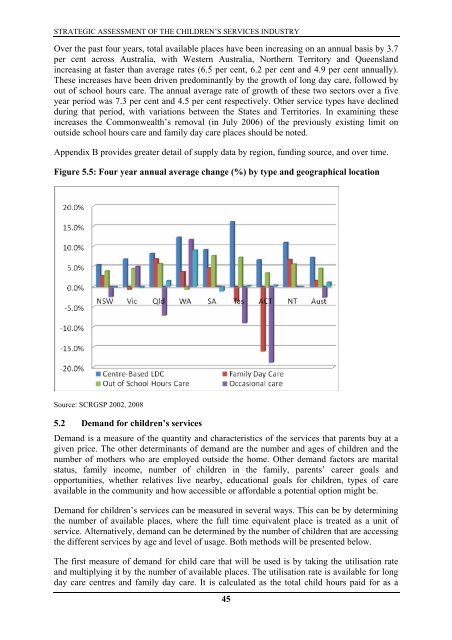A Strategic Assessment of the Children's Services Industry
A Strategic Assessment of the Children's Services Industry
A Strategic Assessment of the Children's Services Industry
- No tags were found...
You also want an ePaper? Increase the reach of your titles
YUMPU automatically turns print PDFs into web optimized ePapers that Google loves.
STRATEGIC ASSESSMENT OF THE CHILDREN’S SERVICES INDUSTRYOver <strong>the</strong> past four years, total available places have been increasing on an annual basis by 3.7per cent across Australia, with Western Australia, Nor<strong>the</strong>rn Territory and Queenslandincreasing at faster than average rates (6.5 per cent, 6.2 per cent and 4.9 per cent annually).These increases have been driven predominantly by <strong>the</strong> growth <strong>of</strong> long day care, followed byout <strong>of</strong> school hours care. The annual average rate <strong>of</strong> growth <strong>of</strong> <strong>the</strong>se two sectors over a fiveyear period was 7.3 per cent and 4.5 per cent respectively. O<strong>the</strong>r service types have declinedduring that period, with variations between <strong>the</strong> States and Territories. In examining <strong>the</strong>seincreases <strong>the</strong> Commonwealth’s removal (in July 2006) <strong>of</strong> <strong>the</strong> previously existing limit onoutside school hours care and family day care places should be noted.Appendix B provides greater detail <strong>of</strong> supply data by region, funding source, and over time.Figure 5.5: Four year annual average change (%) by type and geographical locationSource: SCRGSP 2002, 20085.2 Demand for children’s servicesDemand is a measure <strong>of</strong> <strong>the</strong> quantity and characteristics <strong>of</strong> <strong>the</strong> services that parents buy at agiven price. The o<strong>the</strong>r determinants <strong>of</strong> demand are <strong>the</strong> number and ages <strong>of</strong> children and <strong>the</strong>number <strong>of</strong> mo<strong>the</strong>rs who are employed outside <strong>the</strong> home. O<strong>the</strong>r demand factors are maritalstatus, family income, number <strong>of</strong> children in <strong>the</strong> family, parents’ career goals andopportunities, whe<strong>the</strong>r relatives live nearby, educational goals for children, types <strong>of</strong> careavailable in <strong>the</strong> community and how accessible or affordable a potential option might be.Demand for children’s services can be measured in several ways. This can be by determining<strong>the</strong> number <strong>of</strong> available places, where <strong>the</strong> full time equivalent place is treated as a unit <strong>of</strong>service. Alternatively, demand can be determined by <strong>the</strong> number <strong>of</strong> children that are accessing<strong>the</strong> different services by age and level <strong>of</strong> usage. Both methods will be presented below.The first measure <strong>of</strong> demand for child care that will be used is by taking <strong>the</strong> utilisation rateand multiplying it by <strong>the</strong> number <strong>of</strong> available places. The utilisation rate is available for longday care centres and family day care. It is calculated as <strong>the</strong> total child hours paid for as a45
















